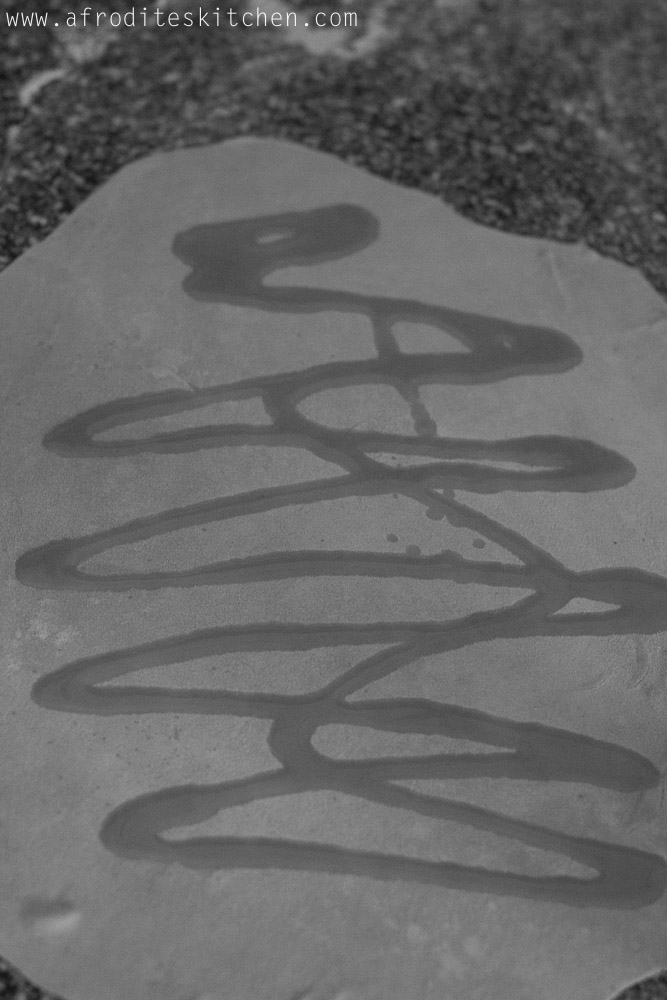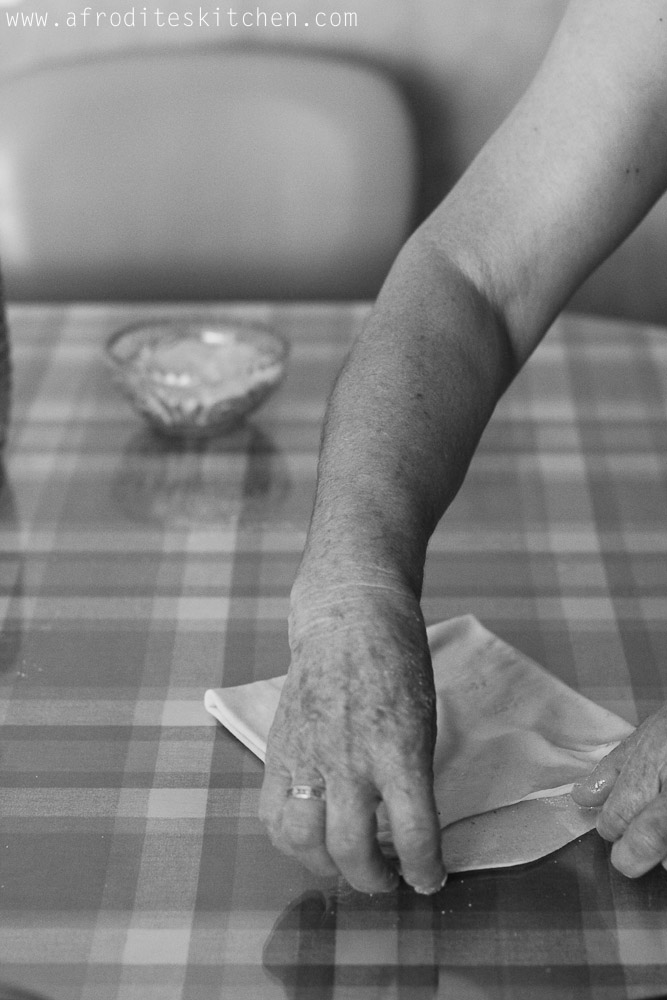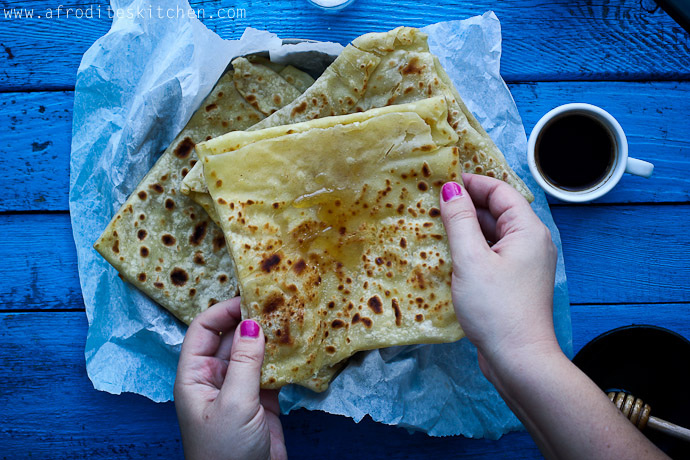for the dough
1kg Village Flour
2 & 1/2 cups warm water
1 tsp salt
scant 1/4 cup olive oil
for the filling
1 tsp cinnamon
3/4 cup sugar
olive oil
honey and sugar for drizzling on top
flour for dusting
1. In a large bowl suitable for kneading dough in, mix together the flour, warm water, salt and olive oil. Knead vigorously for about ten minutes. You could also make the dough in a mixer using a dough hook attachment – I have not tried this, but I don’t see why not, and in fact I will probably do this myself next time.
2. Wrap the dough in a plastic bag (yes, in a plastic bag – I think you could wrap it in a bowl with plastic wrap on top, but I actually quite liked how soft the dough became as a result of the plastic bag technique so will keep it) and let it rest in a warm place for about 30 to 45 minutes.
3. While the dough is resting, in a small bowl mix together the cinnamon and sugar.
4. Once the dough is ready, take a small handful and place it on a floured surface. Using a wide rolling pin roll out the dough so that it becomes very thin – about 2mm thick – in a square-ish shape (about 30-40 cm wide around the edges). You can cut the edges off with a knife to make the shape more square-like if necessary. Also, this is the tricky part. The dough likes to stick to the surface, so make sure the surface is properly floured. And if you have to lift up the dough, then you can roll it around the rolling pin and move it, like in the pictures. If you use a lot of flour then make sure you dust off as much as possible before you cook the “katimeri” as the flour will burn and affect the taste of the “katimeri”.
5. Once you have a thin square shape, drizzle a scant 1/4 cup of olive oil on it. Take each edge and quickly and gently press it into the center of the “katimeri” so that the surface is well coated, as in the picture.
6. Then sprinkle about 1 tbs of the sugar/cinnamon mix on top. (If you would like your “katimeri” very sweet, you can sprinkle more of the sugar/cinnamon mix, but I prefer to add honey after it has been cooked for extra sweetness instead.)
7. Fold the “katimeri” into a little square sized envelopes, as in the pictures. Fold each side in, and then bring the bottom to just below the top, and fold over the excess dough to close the square – like a little envelope top. If you have any questions, just drop me a comment below and I can explain it a bit better.
8. Preheat a skillet on high heat. Add one “katimeri” at a time and let it cook for about 1 minute before turning it over. Then let it cook for about 1 minute before turning it over again. After 1 minute, turn it over again. It needs to be cooked for about 3 to 4 minutes, you can tell when it is ready as the “katimeri” will have light to dark golden brown spots on either side.
9. Place the cooked “katimeri” in a large cover pot. Sprinkle a little sugar (1/4 tsp) on top of each “katimeri” before layering another “katimeri” on top as this will keep them soft. Serve the same day, drizzling with as much honey as you wish on top.



















I love katimeria Christina. They are delicious!! Do I spy your grandmother making them? 🙂
Congrats on the new car! You know you have my dream car right? Bright yellow VW bug! I can’t believe it!
Thanks for sharing you top 10 things that make you happy. I wish you always have all 10!
Thanks Magda!! <3 Yes, my auntie Evri!! I went over to measure the ingredients and learn and I was rolling out my dough on the surface and she was laughing and scolding me as I was going along - "no, no, that isn't right ... you will eat this one"!! haha, thank you ! I love the yellow bug much more than my old car which was the first car I ever bought myself (a Rav 4) and very dog friendly but such a gas guzzler!! Thank you Magda, and I wish for you to always have your top 10 as well! <3 <3 <3
Thanks so much for sharing the things that make you happy, this post was such a delight to read. I can’t wait to make these pancakes, they look divine! xx
Thank you for this recipe 😀 i tried it yesterday but i think i have to adjust the thickness a little bit.. will try it again soon 🙂
Hi Natalie! Thank you for stopping by! The thickness is probably the trickiest part of this recipe I think! Even when I was rolling out mine, my aunt was “tut-tutting” me because it wasn’t thin enough — with the consequence that they already chewy bread because thick. Even when made properly these guys are a little on the “thick” side, but I just roll them up and drizzle them in honey so make them sweeter. So I think (hope) the key is in the thickness – did you try the flipping technique with the rolling pin in the pictures? I think it’s important as it’s the only way I could make them thin enough without sticking to the table! … Maybe try rolling them out on baking paper, as that could help? Let me know how it goes! xx
Very good recipe, but the original recipe is from Viki-Chios-Greece.. they are 2 types of katimeri. The Karakoziko and Michaliko. 2 families in the village of Viki. Ancient recipe and very tastefull. They do it with another way. SECRET! 🙂
Hi Aphrodite
With this Katimeri recipe is the Mitsides Village Flour Plain or self raising flour or some other type taht I maybe able to get in Australia.
Living in Australia its hard to get thjings made in Cyprus.
I remember having these every time when I go to Cyprus and just love them when they are freshly made at one of the local take away shops that specialise in these & Chamechi (special custard fill pastry)then cook in oil.
Hi Christoss, thanks for your message. I just wrote an article about Cyprus flours here, which you might want to take a look as it explains that Cyprus Village flour is essentially yellowish durum flour. So if I were you I would basically find out where you can buy that, and that should help. Otherwise, the Village Flour is high in protein, so you will need to find a flour like that, but it’s described in the article which I hope will help! And yes, they are FANTASTIC fresh (not so much the next day if you ask me!).
Hello. Recently we took my Father in law to Cyprus where he grew up. He bought this wonderful dessert for my children and I would love to make it for him. We live in the U.S. And I cannot find that flour. Is sorhgum flour a good substitute? I noticed it is very high in protein. If not, what flour do you suggest other than Durham? Thank you so much
Hi Mari, I would try bread flour? I am not sure about sorhgum flour because I haven’t cooked with it, but village flour is very similar to bread flour. There is also a website in Cyprus that I think can export flour to you in the US if you are interested in that?
hey mari,
I live in the states as well and I’ve found that ‘Bob’s red mill’ makes a good durham semolina flour that seems to work well as a substitute. Here’s a link on amazon: http://www.amazon.com/Bobs-Red-Mill-Semolina-24-ounces/dp/B001HTKP0I
That brand is pretty good in general too and has alot of different kinds (including stuff like almond meal).
Also btw, I love you blog, all the recipes I know from my family either I didn’t write down and forgot or else they use very imprecise measurements, so this is a great resource for me! Thanks so much!
The katimeria I know are made with vinegar in the dough.when cooked they are served with grated cheese , either feta or Parmesan and are very filling. Never had the ones made with cinnamon topping will try.